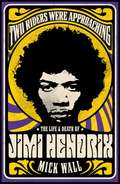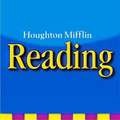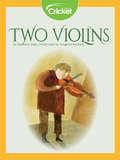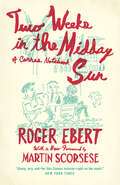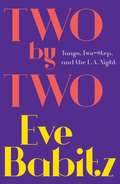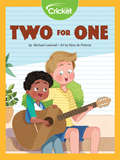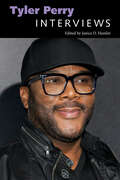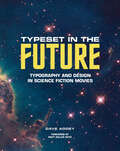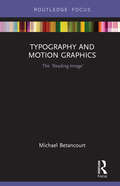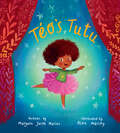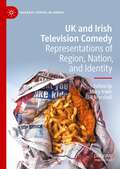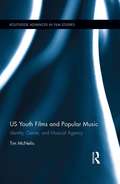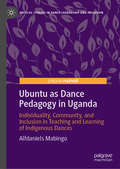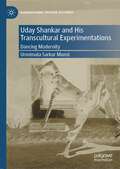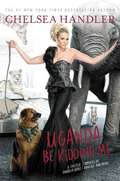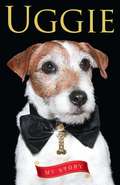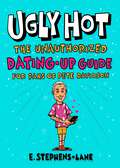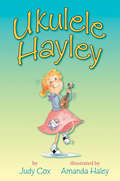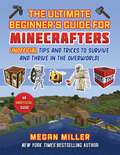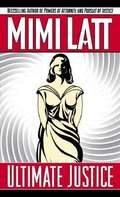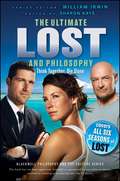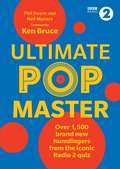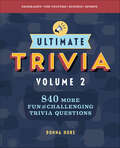- Table View
- List View
Two Riders Were Approaching: The Life & Death of Jimi Hendrix
by Mick WallJimmy was a down-at-heel guitarist in New York, relying on his latest lovers to support him while he tried to emulate his hero Bob Dylan. A black guy playing white rock music, he wanted to be all things to all people.But when Jimmy arrived in England and became Jimi, the cream of swinging London fell under his spell. It wasn't that Jimi could play with his teeth, play with his guitar behind his back. It was that he could really play.Journeying through the purple haze of idealism and paranoia of the sixties, Jimi Hendrix was the man who made Eric Clapton consider quitting, to whom Bob Dylan deferred on his own song 'All Along the Watchtower', who forced Miles Davis to reconsider his buttoned-down ways - and whose 'Star Spangled Banner' defined Woodstock. And when his star, which had burned so brightly, was extinguished far too young, his legend lived on in the music - and the intrigue surrounding his death. Eschewing the traditional rock-biography format, Two Riders Were Approaching is a fittingly psychedelic and kaleidoscopic exploration of the life and death of Jimi Hendrix - and a journey into the dark heart of the sixties. While the groupies lined up, the drugs got increasingly heavy and the dream of the sixties burned in the fire and blood of the Vietnam War, the assassination of Martin Luther King and the election of President Richard Nixon. Acclaimed writer Mick Wall, author of When Giants Walked the Earth, has drawn upon his own interviews and extensive research to produce an inimitable, novelistic telling of this tale - the definitive portrait of the Guitar God at whose altar other guitar gods worship.Jimi Hendrix's is a story that has been told many times before - but never quite like this.
Two Riders Were Approaching: The Life & Death of Jimi Hendrix
by Mick WallJimmy was a down-at-heel guitarist in New York, relying on his latest lovers to support him while he tried to emulate his hero Bob Dylan. A black guy playing white rock music, he wanted to be all things to all people.But when Jimmy arrived in England and became Jimi, the cream of swinging London fell under his spell. It wasn't that Jimi could play with his teeth, play with his guitar behind his back. It was that he could really play.Journeying through the purple haze of idealism and paranoia of the sixties, Jimi Hendrix was the man who made Eric Clapton consider quitting, to whom Bob Dylan deferred on his own song 'All Along the Watchtower', who forced Miles Davis to reconsider his buttoned-down ways - and whose 'Star Spangled Banner' defined Woodstock. And when his star, which had burned so brightly, was extinguished far too young, his legend lived on in the music - and the intrigue surrounding his death. Eschewing the traditional rock-biography format, Two Riders Were Approaching is a fittingly psychedelic and kaleidoscopic exploration of the life and death of Jimi Hendrix - and a journey into the dark heart of the sixties. While the groupies lined up, the drugs got increasingly heavy and the dream of the sixties burned in the fire and blood of the Vietnam War, the assassination of Martin Luther King and the election of President Richard Nixon. Acclaimed writer Mick Wall, author of When Giants Walked the Earth, has drawn upon his own interviews and extensive research to produce an inimitable, novelistic telling of this tale - the definitive portrait of the Guitar God at whose altar other guitar gods worship.Jimi Hendrix's is a story that has been told many times before - but never quite like this.
Two Times Intro: On The Road With Patti Smith
by Michael Stipe"In Stipe’s startling photographs and 12 brief written homages, Patti Smith is depicted as a down-to-earth goddess, a part of and apart from her evolving entourage of musicians, artists, poets (Allen Ginsberg makes an appearance), and friends. This isn’t a traditional book of portraits . . . The overwhelming mood is one of disjunction, claustrophobia, exhaustion, temporariness--and the effect is raw and intimate . . . And [Stipe] is no longer the "dork nerd" teenager, but a fellow musician -- and from his proud, caring mien, even a protector."--Publishers Weekly"An energetic and gracious tribute to not only a great artist, but also to a powerful moment in her oeuvre -- and to those who contributed to it and shared in it."--New York Journal of Books"Stipe's personal friendship lends something greater to the overall vision of this book. It isn't simply a set of snapshots of performances, rather a collection of rare moments. The personal nature of the anthology makes it all the more enticing and enjoyable. Smith, in all her glory and awe-inspiring talent, is portrayed in the truest light."--Verbicide Magazine"A fascinating book . . . including appearances by Allen Ginsberg, Gregory Corso, Tom Verlaine, the members of Sonic Youth and more . . . and the short text tributes to Smith by these people, scattered throughout the manuscript, are well worth your time."--Chicago Center for Literature and PhotographyThis book comprises Michael Stipe's intimate and evocative photos of Patti Smith on tour in 1995, along with other cultural celebrities who appeared with her, such as Allen Ginsberg. In addition to text by Stipe, William Burroughs, and Patti Smith, there is also commentary from Thurston Moore, Kim Gordon, Lenny Kaye, Tom Verlaine, and more.Michael Stipe is a singer, photographer, film producer, and activist. He lives in Athens, GA, and New York, NY. R.E.M. formed in 1980 in Athens, GA, and is composed of Peter Buck, Mike Mills, and Michael Stipe. Heralded by Rolling Stone as "America's Best Rock and Roll Band," R.E.M. rose from cult college radio status to sell more than seventy million albums worldwide and was inducted into the Rock and Roll Hall of Fame in 2007.
Two Traditions of Dance (Houghton Mifflin Harcourt Vocabulary Readers #Leveled Reader: Level: 5, Theme: 4.3)
by Stanford MakishiAn introduction to different forms of dance.
Two Violins
by Darienne OaksMoshe is a frightened young boy when he and his family must flee their hometown from the Nazis. He risks starvation to find his way into the home of a Good Samaritan. Afraid he has lost his family in the Holocaust, Moshe carries on in the only way he knows how: by playing his violin.
Two Weeks in the Midday Sun: A Cannes Notebook
by Roger EbertA paragon of cinema criticism for decades, Roger Ebert—with his humor, sagacity, and no-nonsense thumb—achieved a renown unlikely ever to be equaled. His tireless commentary has been greatly missed since his death, but, thankfully, in addition to his mountains of daily reviews, Ebert also left behind a legacy of lyrical long-form writing. And with Two Weeks in the Midday Sun, we get a glimpse not only into Ebert the man, but also behind the scenes of one of the most glamorous and peculiar of cinematic rituals: the Cannes Film Festival. More about people than movies, this book is an intimate, quirky, and witty account of the parade of personalities attending the 1987 festival—Ebert’s twelfth, and the fortieth anniversary of the event. A wonderful raconteur with an excellent sense of pacing, Ebert presents lighthearted ruminations on his daily routine and computer troubles alongside more serious reflection on directors such as Fellini and Coppola, screenwriters like Charles Bukowski, actors such as Isabella Rossellini and John Malkovich, the very American press agent and social maverick Billy “Silver Dollar” Baxter, and the stylishly plunging necklines of yore. He also comments on the trajectory of the festival itself and the “enormous happiness” of sitting, anonymous and quiet, in an ordinary French café. And, of course, he talks movies. Illustrated with Ebert’s charming sketches of the festival and featuring both a new foreword by Martin Scorsese and a new postscript by Ebert about an eventful 1997 dinner with Scorsese at Cannes, Two Weeks in the Midday Sun is a small treasure, a window onto the mind of this connoisseur of criticism and satire, a man always so funny, so un-phony, so completely, unabashedly himself.
Two by Two: Tango, Two-Step, and the L.A. Night
by Eve BabitzA Simon & Schuster eBook. Simon & Schuster has a great book for every reader.
Two for One
by Michael LeannahPetey has been practicing playing his guitar for the school talent show. He plans to perform a song he wrote himself. One day he hurts his arm and has to wear a cast. How can he play guitar now? A good friend shows him how.
Tyler Perry: Interviews (Conversations with Filmmakers Series)
by Janice D. HamletA career-spanning volume, Tyler Perry: Interviews collects sixteen interviews, ranging from the early 2000s to 2018. Once a destitute and struggling playwright, Tyler Perry (b. 1969) is now a multimedia phenomenon and one of the most lucrative auteurs in Hollywood. Known for his unwavering and audacious rhetorical style, Perry has produced an impressive body of work by rejecting Hollywood’s procedures and following his personal template. Featuring mostly African American actors and centering primarily on women, Perry’s films lace drama and comedy with Christianity. Despite the skepticism of Hollywood executives who claimed that church-going black people do not go to the movies, Perry achieved critical success with the release of his first film, Diary of a Mad Black Woman, which became the US’s highest-grossing movie of 2005. With his movies, Perry has discovered an untapped audience for the stories he has to offer—stories about adversity, faith, family, and redemption. Critics, including African American filmmaker Spike Lee, have censured Perry’s work for being repetitive and reinforcing negative stereotypes that have long plagued the African American community. Supporters, however, praise Perry for creating films that allow his audience to see themselves onscreen. Regardless of how his films are received, Perry’s accomplishments—establishing the Tyler Perry brand, building one of the largest movie studios in the country, employing more African Americans in front of and behind the camera than any other studio, and creating cinematic content for audiences other filmmakers have ignored—undeniably establish him as one of the most powerful multimedia moguls in the country.
Typeset in the Future: Typography and Design in Science Fiction Movies
by Dave AddeyA designer’s deep dive into seven science fiction films, filled with “gloriously esoteric nerdery [and] observations as witty as they are keen” (Wired).In Typeset in the Future, blogger and designer Dave Addey invites sci-fi movie fans on a journey through seven genre-defining classics, discovering how they create compelling visions of the future through typography and design. The book delves deep into 2001: A Space Odyssey, Star Trek: The Motion Picture, Alien, Blade Runner, Total Recall, WALL·E, and Moon, studying the design tricks and inspirations that make each film transcend mere celluloid and become a believable reality. These studies are illustrated by film stills, concept art, type specimens, and ephemera, plus original interviews with Mike Okuda (Star Trek), Paul Verhoeven (Total Recall), and Ralph Eggleston and Craig Foster (Pixar). Typeset in the Future is an obsessively geeky study of how classic sci-fi movies draw us in to their imagined worlds.
Typography and Motion Graphics: The 'reading-image' (Routledge Studies In Media Theory And Practice Ser.)
by Michael BetancourtIn his latest book, Michael Betancourt explores the nature and role of typography in motion graphics as a way to consider its distinction from static design, using the concept of the ‘reading-image’ to model the ways that motion typography dramatizes the process of reading and audience recognition of language on-screen. Using both classic and contemporary title sequences—including The Man With the Golden Arm (1955), Alien (1979), Flubber (1998), Six Feet Under (2001), The Number 23 (2007) and Scott Pilgrim vs. The World (2010)—Betancourt develops an argument about what distinguishes motion graphics from graphic design. Moving beyond title sequences, Betancourt also analyzes moving or kinetic typography in logo designs, commercials, film trailers, and information graphics, offering a striking theoretical model for understanding typography in media.
Téo's Tutu
by Maryann Jacob MaciasThis story of a boy's first ballet recital celebrates gender-creativity, the joy of dance, and being yourselfTéo loves to dance, whether it's the cumbia with Papí, the bhangra with Amma, or ballet class with Miss Lila. He also loves the way his tutu makes him feel, inside and out. But when it comes time to decide which outfit to wear in the big dance recital--a sparkly tutu or shimmering silver pants--Téo wonders if being his most authentic self on stage will put him too much in the spotlight.
UK and Irish Television Comedy: Representations of Region, Nation, and Identity (Palgrave Studies in Comedy)
by Jill Marshall Mary IrwinThis book looks at television comedy, drawn from across the UK and Ireland, and ranging chronologically from the 1980s to the 2020s. It explores depictions of distinctive geographical, historical and cultural communities presented from the insiders’ perspective, simultaneously interrogating the particularity of the lived experience of time, and place, embedded within the wide variety of depictions of contrasting lives, experiences and sensibilities, which the collected individual chapters offer. Comedies considered include Victoria Wood’s work on ‘the north’, Ireland’s Father Ted and Derry Girls, Michaela Coel’s east London set Chewing Gum, and Wales’ Gavin and Stacey. There are chapters on Scottish sketch and animation comedy, and on series set in the Midlands, the North East, the South West and London’s home counties. The book offers thoughtful reflection on funny and engaging representations of the diverse, fragmented complexity of UK and Irish identity explored through the intersections of class, ethnicity and gender.
US Youth Films and Popular Music: Identity, Genre, and Musical Agency (Routledge Advances in Film Studies)
by Tim McNelisThis book brings theory from popular music studies to an examination of identity and agency in youth films while building on, and complementing, film studies literature concerned with genre, identity, and representation. McNelis includes case studies of Hollywood and independent US youth films that have had commercial and/or critical success to illustrate how films draw on specific discourses surrounding popular music genres to convey ideas about gender, race, ethnicity, sexuality, and other aspects of identity. He develops the concept of ‘musical agency’, a term he uses to discuss the relationship between film music and character agency, also examining the music characters listen to and discuss, as well as musical performances by the characters themselves
Ubuntu as Dance Pedagogy in Uganda: Individuality, Community, and Inclusion in Teaching and Learning of Indigenous Dances (Critical Studies in Dance Leadership and Inclusion)
by Alfdaniels MabingoThis book locates the philosophy of Ubuntu as the undergirding framework for indigenous dance pedagogies in local communities in Uganda. Through critical examination of the reflections and practices of selected local dance teachers, the volume reveals how issues of inclusion, belonging, and agency are negotiated through a creatively complex interplay between individuality and communality. The analysis frames pedagogies as sites where reflective thought and kinaesthetic practice converge to facilitate ever-evolving individual imagination and community innovations.
Uday Shankar and His Transcultural Experimentations: Dancing Modernity (Transnational Theatre Histories)
by Urmimala Sarkar MunsiThis monograph presents a specific experience of modernity within the context of Indian dance by looking at the transcultural journey of Indian dancer / choreographer Uday Shankar (1900b – 1977d). His popularity in Europe and America as an Oriental male dancer in the first half of the 20th century, and his worldwide recognition as the Ambassador of Indian culture, are brought into a historiographical perspective within the cultural and social reforms of early twentieth century India. By exploring his artistic journey beyond India in the period between the two world wars, and his experience of dance making, presentational technique and representation of India through various phases of his life, a path is forged to understanding the emergence of modernity in Indian dance.
Uganda Be Kidding Me
by Chelsea HandlerThe author who is a stand-up comedian herself, describes her travel adventures and misadventures during a trip to Africa with her friends.
Uggie--My Story: My Story
by UggieA heartwarming memoir by the Jack Russell Terrier that starred in The Artist and Water for Elephants.Uggie&’s memoir offers readers the true rags-to-riches tale of one ordinary Jack Russell Terrier who made it big in Hollywood. For the first time, Uggie tells his story of rising from humble beginnings as an abandoned shelter dog to being adopted by esteemed trainer Omar Von Muller. Uggie details his time starring in commercials for everything from Kia cars to Bud Light. Uggie eventually broke into the film world with his appearance in Mr. Fixit in 2006. He went on to appear in Wassup Rockers and Life is Ruff. Uggie got his first serious film role in 2011's Water for Elephants where he starred alongside Reese Witherspoon and Robert Pattinson. It was not, however, until 2012's The Artist that Uggie really dazzled audiences with his talents. In his memoir, Uggie will talk about life on the set of the Oscar-winning film and the role that many said should have earned him an Oscar. Uggie's memoir doesn't just hit on his career highlights, it also takes a candid look at his his private demons: overcoming a painful past as a cat-murderer and finding redemption; living with shaking syndrome; his regret at never siring any pups before being neutered. Uggie's memoir will include not just biographical information, but also advice from the dog himself. As is seen in his dazzling performance in The Artist, Uggie is an incredibly talented performer. He honed his craft while touring South America each year as part of The Incredible Dog Show, and in his memoir, he will spend several chapters sharing practical training and dieting tips that he has developed over the years.
Ugly Hot: The Unauthorized Dating-Up Guide for Fans of Pete Davidson
by E. Stephens-LaneHow does he do it?We can’t all be drop-dead gorgeous, but we can all be ugly hot! Pete Davidson’s unlikely rise from the depths of his mom’s basement to the upper echelons of fame and straight into the arms of A-listers like Ariana Grande, Kate Beckinsale, Kim Kardashian, and Emily Ratajkowski gives hope to us all. With meticulous analysis, insightful quotes, scientific-ish studies, admittedly irrelevant trivia, and loads of cheeky humor, Ugly Hot: The Unauthorized Dating-Up Guide for Fans of Pete Davidson holds all the secrets to finding love above your station, just like Pete. Follow the magical journey of a Staten Island everyman–turned–Hollywood playboy and collect valuable knowledge along the way, including:- How to exude supreme confidence and give off that BDE!- How to use humor and questionable fashion to your advantage- How to be vulnerable in a way that’s more sexy than annoying- How to low-key seduce someone who seems way out of your leagueWith wisdom gained from observing Pete’s public romances, this guide is designed to give everyone a fighting chance. Because if Pete can win at love, so can you!
Ukulele Hayley
by Judy Cox Amanda HaleyEveryone has a talent, right? Hayley is sure she has one, but she's having trouble pinpointing it. Then Hayley buys a ukulele at a yard sale. Learning to play takes practice, but it's fun, fun, fun. Before long Hayley is strumming up a storm, and her classmates want in on the action. Then terrible new threatens not only the new uke band, but the whole school music program. Now it's up to Hayley and her band to come up with a creative plan to keep their school rocking.
Ultimate Beginner's Guide for Minecrafters: Unofficial Tips and Tricks to Survive and Thrive in the Overworld!
by Megan MillerThe most comprehensive guide available for new players learning the ropes of the world's most popular game—Minecraft! NOT OFFICIAL MINECRAFT PRODUCT. NOT APPROVED BY OR ASSOCIATED WITH MOJANG. Immerse yourself in a new, vibrant, delightful world—exploring, fishing, farming, fighting (if you want), fossil-hunting, and so much more. Unlike any other game world, in Minecraft, you can touch, pick up, and place pretty much anything you see, anywhere; you can travel as far as you want in any direction, from desert to ocean to snowy mountains and crystal caves; and you can create any structure, from a humble animal pen to a giant working rollercoaster, using just the blocks the world is made of. There&’s just so much to do in Minecraft that it&’s very easy to overlook some of the extensive and fantastic gameplay. This guide will show you how to survive and thrive in this deep, broad, and complex world. It&’s chock full of pro tips, challenges, and step-by-step instructions that will get you on the ground and running—and sneaking, boating, swimming (or even flying with rare elytra wings)! From how to find or build a simple shelter on your first night, to finding exotic hidden temples (and loot) and dimensions, this guide will step you through the must-know basics, including: What to do on your first day (and second, and third, and more!)The important places to visit and lootHow to travel and what to bring with youHow to avoid getting lostHow to gain the upper hand with skeletons, zombies, and other creepy mobsThe sturdiest and strongest weapons and tools to craftHow to build and destroy (TNT anyone?)The best way to mine for precious diamondsWhere to go if you like a battle (and how to avoid them!)How to find the hidden dimensions (and denizens) like the Nether and the EndPro tips, challenges, and step-by-step activities to get you in the groove
Ultimate Justice
by Mimi LattFrom the Back Cover. Edited. When gifted New York prosecutor Alexandra Locke puts her rising career on hold to be near her dying mother, she hesitatingly accepts a position in the office of her father, Thomas Kendall, the politically ambitious Los Angeles District Attorney. But their already strained father-daughter relationship grows far worse when Alexandra hears a shocking deathbed confession. . Flying in the face of her father's re election bid, Alexandra vows to investigate. . Alexandra joins forces with her handsome former lover and together they pry open a case that was once nailed shut.
Ultimate Lost and Philosophy: Think Together, Die Alone
by Sharon KayeAn action-adventure story with more than a touch of the metaphysical, Lost forces viewers to ask difficult questions of themselves just as the story asks difficult questions of its characters. Ultimate Lost and Philosophy helps you explore the deeper meaning and philosophical questions hidden within every complex twist and turn in the historic TV show's entire six-season run.
Ultimate PopMaster: Over 1,500 brand new questions from the iconic BBC Radio 2 quiz
by Phil Swern Neil MynersDo you stop for PopMaster?Get ready to take on the ultimate PopMaster challenge from the minds behind BBC Radio 2's iconic quiz. Every weekday morning over eight million people across the nation stop what they're doing, fix themselves a cuppa and settle in to listen to the PopMaster quiz on The Ken Bruce Show. Now it's your turn to join the throng and pit your musical knowledge against expert question setters Phil Swern and Neil Myners.Ultimate PopMaster is an endlessly entertaining collection of brainteasers, featuring a foreword from the Pop Master himself, Ken Bruce, and 1,500 brand new questions that get progressively harder as you work your way through the book. Discover a surprise twist when you reach the final quiz, in which you'll get the chance to become ultimate PopMaster champion.Covering music from 1958 to 2020, this official quiz companion has something for everyone. So, whether you're a pop anorak or incidental music fan, get stuck in on your own or with friends and family, and watch the hours fly by. Who had a top 10 hit in 1997 with 'The James Bond Theme' as featured in the movie Tomorrow Never Dies? Which legendary soul singer was the subject of the 2015 number one hit by Charlie Puth featuring Meghan Trainor? Which group of comedians had a Top 10 hit in 1975 with Black Pudding Bertha (The Queen Of Northern Soul)?
Ultimate Trivia, Volume 2: 840 More Fun and Challenging Trivia Questions
by Donna HokeSerious trivia challenge—840 questions to rack your brainWhether playing in a pub, along with a TV show, or at a party, people can't get enough of trivia. Keep up with its rising resurgence with Ultimate Trivia, Vol. 2., the book that will put your general knowledge skills through the wringer.What is the largest muscle in the human body? Who designed the city of Washington, D.C.? With over 800 more engaging questions, from geography to pop culture, sports to science, this mind-challenging guide is anything but trivial.Ultimate Trivia, Vol. 2 includes:All new questions—Fresh topics include television shows and movies, capitals of countries, and football—it's all in here.Anywhere with anyone—Pit two groups against each other during a party or go head-to-head at the bar with a friend to see who comes out as a trivia boss.Thoroughly vetted—All the information has been vigorously fact-checked to ensure everything is accurate and up to date.When it comes to trivia books that will put your brain to the test, this one rises above the rest.
